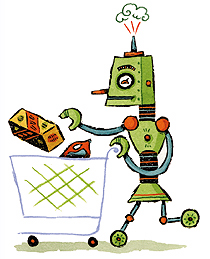Jun 05, 2007By Kevin Ashton
Electronic Product Code technology was developed primarily for the supply chain, but now it's emerging in a wide range of other applications—from asset tracking to location awareness. And that's enabled some potential killer applications that are real now, nearly real or in the concept stage. They all point to the power and flexibility of RFID, and show why it is one of the most important new technologies of the 21st century.
Smart shopping carts. Media Cart, a Texas-based startup, is using EPC technology to help shoppers find the items they need. The company put RFID readers in shopping carts and placed location tags in stores. Result: The cart knows where it is, and it draws maps to show shoppers quick routes to things they can't find. This application is in live tests now. If successful, there could be hundreds of thousands of mobile RFID readers roaming stores by the end of the decade.
Physical interfaces. Academics have been playing with RFID as an interface technology for years, manipulating physical things to control computers instead of using on-screen icons. Now Apple has filed a patent application that may point the way for these physical interfaces to become real. Instead of consumers pushing buttons and following complex on-screen setup guides, RFID-enabled set-top boxes and other devices could use RFID to find one another. Want to configure your new digital phone to show its pictures on your HDTV? Apple's idea is simple: Just wave the phone over the TV, and let RFID do the rest.
Evacuation management. When a building has to be evacuated, people flee through multiple exits, and may be too shocked or confused to quickly get to pre-assigned assembly points. It is essential to figure out who got out, who wasn't in the building and who may still be trapped. Conventional RFID-based badges can't help here—they have short ranges and can be read only one at a time.
But new UHF badges and readers placed in emergency stairwells could identify who got out and locate people stuck in exits. And privacy concerns just don't apply. When you are trapped in a burning building, you want people to know where you are. At least one major company is already thinking about testing this potentially life-saving application.
Housekeeping robots. I have long dreamed of a Roomba-type RFID-enabled robot that picks up around the house all day. When I described this to editors at USA Today, they christened it the Fetchba, and gave it a page in the business section. There's no such thing as a Fetchba—yet—but this concept shows what could be done if RFID were combined with simple robots to add intelligence to automation.
Real-time maps. RFID could revolutionize one of the oldest information devices known to humanity: the map. Today's online maps aren't that different from paper maps. But soon they could become a real-time window on the world. Services such as Google Maps have a conventional limitation—their information is static.
RFID could provide a real-time layer for these maps. Instead of searching for the nearest electronics store and hoping it has that hot new video game, you could search the map for the game itself, and see how close you are to the nearest inventory.
Kevin Ashton was cofounder and executive director of the Auto-ID Center. Illustration by Adam McCauley Collection.


